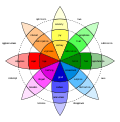Curiosity
This article needs additional citations for verification. (November 2009) |

Curiosity (from Latin curiosus "careful, diligent, curious," akin to cura "care") is an emotion related to natural inquisitive behavior such as exploration, investigation, and learning, evident by observation in human and many animal species. The term can also be used to denote the behavior itself being caused by the emotion of curiosity. As this emotion represents a drive to know new things, curiosity is a major driving forces behind scientific research and other disciplines of human study.
Causes

Although many living beings have an innate capability of curiosity, it should not be categorized as an instinct because it is not a fixed action pattern; rather it is an innate basic emotion because while curiosity can be expressed in many ways, the expression of an instinct is typically more fixed and less flexible. Curiosity is common to human beings at all ages from infancy[1] through adulthood,[2] and is easy to observe in many other animal species. These include apes, cats, rodents,[3] fish, reptiles, and insects; as well as many others.[citation needed] Many aspects of exploration are shared among all beings, as all known terrestrial beings share similar aspects: limited size and a need to seek out food sources.[vague]
In fact, in its development as wonder or admiration, it is generally curiosity that makes a human being want to become an expert in a field of knowledge.[citation needed] Though humans are sometimes considered particularly curious, they sometimes seem to miss the obvious when compared to other animals. What seems to happen is that human curiosity about curiosity itself (i.e. meta-curiosity or meta-interest), combined with the ability to think in an abstract way, leads to mimesis, fantasy and imagination - eventually leading to an especially human way of thinking ("human reason"), which is abstract and self-aware, or conscious. Readers of this page who are curious about meta-curiosity are experiencing meta-meta-curiosity.
Brain
The degree to which a person says that they have curiosity about trivia questions links to activity both in the Broca's area in their left inferior frontal gyrus and in the putamen in their basal ganglia. This suggests that people experiencing curiosity activate not only parts of their brain that comprehend and anticipate information, but also those parts in which such information acts as a secondary reinforcer or reward. Curiosity also increases activity in memory areas such as the hippocampus when subjects guess trivia questions incorrectly - this suggests that it might act to enhance a person's long-term memory for surprising new information. Such activation linked to curiosity predicted better recall of surprising answers one or two weeks later.[4] Dopamine receptors in part of the hippocampus called the dentate gyrus contribute to the generation of a spontaneous exploratory behavior in mice, that may be akin to curiosity in humans.[5] These receptors, and the protein NCS-1 that regulates their expression,[5][6] also play important roles in plasticity and learning and therefore may represent a molecular link between intelligence and curiosity.[7]
Morbid curiosity

A morbid curiosity is an example of addictive curiosity, the object of which is death, violence, or any other event that may hurt you physically or emotionally (see also: snuff film), the addictive emotion being explainable by meta-emotions exercising pressure on the spontaneous curiosity itself. According to Aristotle, in his Poetics we even "enjoy contemplating the most precise images of things whose sight is painful to us." (This aspect of our nature is often referred to as the 'Car Crash Syndrome' or 'Trainwreck Syndrome', derived from the notorious supposed inability of passersby to ignore such accidents.)
References
- ^ Ofer G, Durban J. (1999). "Curiosity: reflections on its nature and functions". Am J Psychother. 53 (1): 35–51. PMID 10207585.
- ^ Berlyne DE. (1954). "A theory of human curiosity". Br J Psychol. 45 (3): 180–91. PMID 13190171.
- ^ Berlyne DE. (1955). "The arousal and satiation of perceptual curiosity in the rat". J Comp Physiol Psychol. 48 (4): 238–46. PMID 13252149.
- ^ Kang MJ, Hsu M, Krajbich IM, Loewenstein G, McClure SM, Wang JT, Camerer CF. (2009).The wick in the candle of learning: epistemic curiosity activates reward circuitry and enhances memory.Psychol Sci. 20(8):963-73. PMID 19619181
- ^ a b
Saab BJ, Georgiou J, Nath A, Lee FJ, Wang M, Michalon A, Liu F, Mansuy IM, Roder JC. (2009). "NCS-1 in the dentate gyrus promotes exploration, synaptic plasticity, and rapid acquisition of spatial memory". Neuron. 63 (5): 643–56. doi:10.1016/j.neuron.2009.08.014. PMID 19755107.
{{cite journal}}: CS1 maint: multiple names: authors list (link) Cite error: The named reference "pmid19755107" was defined multiple times with different content (see the help page). - ^
Kabbani N, Negyessy L, Lin R, Goldman-Rakic, Levenson R. (2002). "Interaction with neuronal calcium sensor NCS-1 mediates desensitization of the D2 dopamine receptor". J. Neurosci. 22 (19): 8476–86. PMID 12351722.
{{cite journal}}: CS1 maint: multiple names: authors list (link) - ^ http://www.news-medical.net/news/20090917/Molecular-link-between-intelligence-and-curiosity-discovered.aspx
Further reading
- Curiosity and Exploration. Susan Edelman (1997) http://www.csun.edu/~vcpsy00h/students/explore.htm


